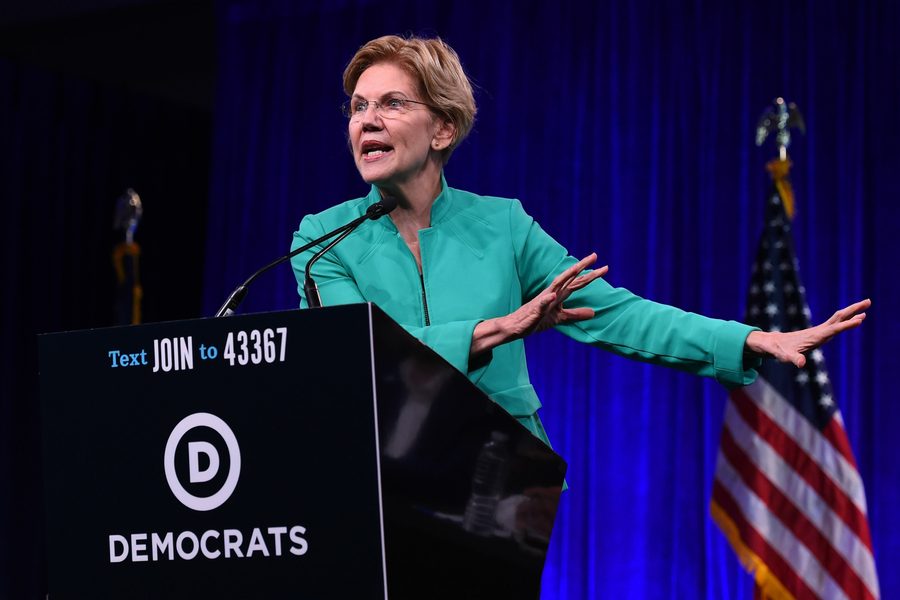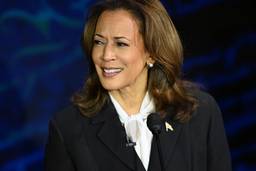Elizabeth Warren Is Making a Mistake By Trying to Win Over Democratic Party Elites
If Warren wants to enact “big, structural change,” working within the Democratic Party establishment is a poor strategy.
Branko Marcetic

With Joe Biden steadily losing ground to his more progressive rivals, the fight for the Democratic presidential nomination is increasingly shaping up into a contest between competing theories of change. As Bernie Sanders continues his ongoing battle with the party establishment, looking to “transform” the party from outside, Elizabeth Warren is reportedly attempting to win over party elites. The New York Times’ Jonathan Martin reports that she is telling party leaders that “far from wanting to stage a ‘political revolution’ in the fashion of Mr. Sanders, she wants to revive the beleaguered Democratic National Committee and help recapture the Senate while retaining the House in 2020.” And on Saturday, NBC News reported that Warren has been speaking with 2016 Democratic nominee Hillary Clinton since announcing her campaign, though little is known about their communications due to the “political sensitivity” involved.
Yet for Warren, who like Sanders intends to enact “big, structural change” in U.S. politics, this strategy presents risks. A survey of Warren’s history working with the Democratic Party, and emails hacked from Clinton campaign chair John Podesta by Russian agents and released by WikiLeaks in 2016, suggest the limits of such a non-confrontational approach to party elites.
In 2015, Warren, elevated in 2014 to a leadership position within the Democratic Party as strategic policy adviser to the Democratic Policy and Communications Committee, faced a choice of how to engage with the party. On the one hand, she could listen to the demands of the party’s base and progressive activists and go to battle with the Democratic establishment by challenging presumptive nominee Hillary Clinton. On the other, she could stay out of the race, continue to build her clout in Congress, and work to push Clinton left through a process of sustained diplomatic outreach. Warren opted for the latter.
A survey of the Clinton campaign’s emails, and what happened during and after the election, show that such outreach had minimal impact. By the end of the election, the Clinton campaign had emphatically rejected the “populist” direction that Warren tried to nudge her in. On several issues — such as the influence of Wall Street, Cabinet appointees and trade — the Clinton campaign quietly went against the wishes of Warren and the progressive wing of the party she represented. Emails show that, rather than actually moving left, the campaign sought ways to placate Warren without adopting her policy prescriptions and tended only to shift when prodded by the threat of an electoral challenge.
A stubborn establishment
On August 26, the New York Times reported that Warren has been aggressively courting Democratic officials behind the scenes, assuring them, in the paper’s telling, that she is a loyal Democrat and does not plan to create her own political or organizing infrastructure outside the party. (The next day, the Association of State Democratic Committees announced that Sanders and a number of other candidates have, like Warren, pledged not to create “any organizing or messaging infrastructure that is parallel or duplicative” to the DNC or state parties.)
Besides trying to convince Democrats that her progressive ideas won’t make her “unelectable,” Warren’s private assurances that she simply wants to breathe new life into the Democratic National Committee (DNC) and help the party recapture Congress, the Times notes, also have a politically strategic element. Thanks to a rule change last year, if no single candidate wins an outright majority of delegates in the primaries — a plausible scenario in this crowded field — the superdelegates will once again have a large role in choosing the nominee, this time on the second ballot. And, should it come down to a second ballot, Warren wants their votes.
It’s unclear how easily these overtures to the DNC will sit with Warren’s plans for major structural change in the United States. To understand why, it’s instructive to look at her attempts to influence the Clinton campaign throughout the 2016 presidential race.
After winning her Senate seat in 2012, Warren became the political tribune for the nation’s progressives. She forged relationships in Congress and she used her national prominence and relationship to the activist community to aggressively challenge the Obama administration on a number of policies. Taking an uncompromising, confrontational approach, Warren succeeded in helping torpedo Wall Street-friendly Larry Summers’ bid for chairman of the Federal Reserve and pushed Obama into issuing an executive order giving relief to student loan borrowers.
After the Democrats’ drubbing in 2014, which saw the party lose the Senate as the GOP increased its House majority, Democratic leadership sought to bring Warren — then preternaturally popular with both liberal groups and the grassroots — into the fold. Senate Minority Leader Harry Reid created a special leadership position just for her, and tasked her with reaching out to the party’s progressive wing — the “Warren wing,” as it was referred to then.
“We’re going to do things a little differently,” Reid pledged.
Warren began doing things a little differently, too. Though she continued to be an outspoken progressive voice, criticize the administration and lead the charge against appointees she deemed unacceptable, she took care to signal she was also a team player that year. Ignoring progressive calls to run for president, Warren instead co-signed a letter urging Hillary Clinton to run, and white-washed her previous criticism of Clinton’s support for an industry-favored bankruptcy bill. While in her 2003 book, Warren had scathingly described Clinton’s shift in opinion on the bill since moving from First Lady to the Senate, arguing Clinton “could not afford such a principled position” anymore because she wanted the financial support of banking executives, her 2014 memoir omitted this history entirely, focusing instead on Clinton convincing her husband Bill to veto the bill in 2000. Clinton would run for the Democratic nomination, it seemed, facing little public pressure from prominent Democrats and no convincing primary challenge, the traditional mechanism by which to pull candidates to the left or right. Warren endorsed Clinton on June 9, 2016, after she had clinched the nomination.
The close of 2014 brought a bad omen for progressives. Only one month after elevating Warren to leadership, Congress — over Warren’s objections and urged on by a coalition of Obama, Reid, Republican House Speaker John Boehner, Wall Street lobbyists and JP Morgan CEO Jaime Dimon—passed a government funding bill that contained a provision written by Citigroup lobbyists that weakened the Dodd-Frank financial reform law’s regulation of the derivatives market. Derivatives swaps had contributed to the 2008 financial crisis, and Warren had argued forcefully against the bill, calling it a “giveaway to the most powerful banks in the country.” The measure passed the with the votes of 57 Democrats in the House, and 31 in the Senate.
In other words, almost as soon as they had given Warren a seat at the table, the Democratic Party leadership — over her objections and still largely resistant to turning left and captive to corporate power — linked arms with Republicans and Wall Street to weaken financial regulations.
The “inside” strategy
A similar dynamic would play out during Warren’s engagement with the Clinton presidential campaign. With neither party looking to antagonize the other, Warren and Clinton met in December 2014 at the Clintons’ home in Chappaqua, New York, a meeting that, according to leaked emails, was originally supposed to have taken place earlier that June. An anonymous Democrat told the New York Times that Clinton used the meeting to solicit policy ideas from Warren, while for Warren, it served as an opportunity to prod Clinton into moving in a more progressive direction on economic policy. Outlets at the time reported on the meeting as a sign that the Clinton campaign would run a more populist campaign.
As email communications between Clinton staffers reveal, the Clinton camp viewed the tête-à-tête as less of an opportunity to get policy ideas and more as an opportunity to placate and manage a potential political roadblock. Staffers plotted out strategy for the conversation, wondering “what [Clinton’s] goals for that meeting should be,” what Warren might challenge her on, what Clinton could ask Warren for help and advice on, and to be “armed with next steps.”
“It would just be such a big deal for this meeting to go well and have EW walk out feeling positive and on board,” said Robby Mook, Clinton’s campaign manager, who floated a plan to “proactively leak” news of the meeting. It was, he wrote, “not a bad thing to put out there that they had a constructive mtg.” When the Times published its report on the meeting that advanced this narrative, Clinton’s Senior Communications Advisor Mandy Grunwald declared privately it was “fine — for both sides.”
Emails show the two camps coordinated after the meeting, working together on a unified post-meeting media strategy and discussing policy. This engagement continued past the December meeting. An early January 2015 email from Clinton’s speechwriter Dan Schwerin to the campaign’s leadership detailed a subsequent hour-and-twenty-minute meeting between him and Dan Geldon, Warren’s longtime adviser.
“He was intently focused on personnel issues, laid out a detailed case against the Bob Rubin school of Democratic policy makers, was very critical of the Obama administration’s choices,” Schwerin wrote of Geldon, referencing Robert Rubin, the former Goldman Sachs executive and Bill Clinton’s Treasury secretary whose vision shaped the financial policies of both the Clinton and Obama presidencies.
“We then carefully went through a list of people they do like, which EW sent over to HRC earlier,” continued Schwerin. “He spoke repeatedly about the need to have in place people with ambition and urgency who recognize how much the middle class is hurting and are willing to challenge the financial industry.” The Warren camp, he reported, was “wary” and “convinced that the Rubin folks have the inside track with us whether we realize it yet or not,” but were “open to engagement and to be proven wrong.”
The two camps would continue to communicate throughout 2016 even as Warren refrained from endorsing Clinton until the end of the primary contest. Amie Parnes and Jonathan Allen reported in Shattered: Inside Hillary Clinton’s Doomed Campaign that Warren maintained a regular back-channel with the campaign to give policy ideas. “We should think about going back to them when we’ve isolated one or two ideas and getting more input on those (without showing our cards, obviously),” Mook wrote in February 2015. “[W]ill probably be in our interest for them to have a sense of where we’re headed before HRC delivers to the public.”
The results of this outreach were mixed at best. Despite these overtures, Clinton ran the opposite of a populist campaign, launching conservative attacks on her opponent Bernie Sanders’ left-wing policies, charging they would “increase the size of the federal government by about 40 percent.” In March 2015, shortly after Warren and Clinton’s camps had begun working together, Clinton announced a plan to tackle inequality that relied on an explicitly apolitical approach, including a “partnership with the public and private sector.” (Ann O’Leary, Clinton’s policy advisor and now chief of staff to California Gov. Gavin Newsom, praised that plan as “affirming of our move away from ‘Wall Street as bad guys’ and toward improving community strength and social fabric as a way of tackling inequality.”)
When it came time to pick a running mate, Clinton declined to choose Warren because, as reported by Parnes and Allen, she wanted “someone who saw the world in a similar way” as her and “didn’t know if she could trust Warren to be pragmatic and constructive.” She ended up instead choosing centrist Virginia Sen. Tim Kaine.
Though it’s impossible to know exactly what a Hillary Clinton cabinet would have looked like, the information available on the last days of the campaign suggests Warren hadn’t convinced Clinton on the subject of personnel either. Having laid low during a primary focused on the malign influence of Wall Street and corporate America, lobbyists, wealthy donors and the finance industry returned to the fold during the 2016 Democratic convention, with investor and private equity executive Alan Patricof quipping: “I think we’re past that.”
Despite criticizing Sanders’ plan to break up big banks for not paying enough attention to “shadow banking,” emails showed that during the campaign, Clinton cultivated a relationship with just such a shadow bank: private equity firm Blackstone, including a February 2016 dinner between two of its executives, as well as Tim Geithner and Larry Summers. Geithner and Summers were both members of the “Bob Rubin school” Warren’s adviser had privately complained about, and had both been Obama appointees with whom Warren had long feuded.
Another Blackstone executive was Tony James, a major fundraiser for Clinton who had been angling for a government post since at least 2014 and was reportedly a choice for an economic policy post under Clinton, including, at one point, Treasury secretary. Around this time, James was pushing a plan to put Americans’ retirement savings in the hands of hedge funds and private equity firms like Blackstone, telling attendees of a Washington D.C. cocktail party that Clinton’s policy advisors “have been very encouraging about the plan,” and that “the signals are warm” that she would “grab this issue once elected, and run with it.”
Though other potential Cabinet appointees didn’t come from the financial world, they were also of concern to progressives. Axios reported in January 2017 that, based on conversations with Clinton staffers, one of her picks for Treasury secretary was Google COO Sheryl Sandberg. (One February 2016 inquiry by John Podesta’s daughter as to whether Warren herself would be considered for the position appears to have been ignored). For Labor secretary, Clinton had reportedly chosen Howard Schultz, the Starbucks billionaire with a long rap sheet of labor abuses who earlier this year threatened to run a third-party campaign if the Democratic Party moves too far left.
On both policy and personnel — the latter being the issue Warren’s team prioritized above all else in early 2015, as Schwerin reported — the more conciliatory “inside” strategy failed to meaningfully sway the Clinton campaign. Indeed, hacked emails paint a picture of a campaign more concerned with how to maneuver around a political headache and quell potential dissent than with genuinely taking on board progressive ideas. This approach mirrored the Democratic leadership’s 2014 elevation of Warren within the party, hoping her presence would get dissatisfied progressives on board even as the Democratic establishment resisted her actual political vision.
Other details from the leaked email tranche support this analysis. Clinton’s staff appeared to be constantly devising ways to placate Warren or prevent her from objecting, without necessarily adopting her views. In one August 2015 email chain, the staff discussed the draft of a joint op-ed by Clinton and Wisconsin Sen. Tammy Baldwin about “slow[ing] Wall Street’s revolving door.” While Mook warned that “Warren and others” could easily paint any defense of the status quo as “corrupted,” campaign adviser Jake Sullivan worried that it demonized anyone from the private sector entering government, and that it could cross the line into “demagoguing.” While the op-ed was eventually published, we now know that such a revolving door was likely going to be a major part of Clinton’s cabinet.
A similar dynamic played out when it came to reviving Glass-Steagall, the Depression-era legislation separating commercial and investment banking that Bill Clinton had essentially repealed towards the end of his presidency. Warren had introduced, and Sanders had co-sponsored, a bill for a 21st Century Glass-Steagall act, and as one email shows, had talked to the Clinton camp about it “numerous” times, along with other financial reform policies. Throughout the campaign, Clinton staff would have feverish discussions around whether or not to support the bill. Clinton ultimately declined to back the measure, which proved to be one of the chief differences between her and Sanders throughout the primaries.
Or take the issue of the Trans-Pacific Partnership (TPP) agreement, negotiated and endorsed by Clinton while she served as secretary of state, but opposed by Warren, Trump, Sanders and organized labor. Warren was a longtime critic of the trade deal and would spend much of 2015 inveighing against the Obama administration’s attempt to pass it. But just as with Glass-Steagall, throughout 2015, the Clinton campaign similarly debated where to stand on the TPP and devised strategies for how to muddy the waters and simply dodge it altogether.
In March 2015, the campaign drafted a statement that outlined what the agreement would need to contain in order to garner U.S. support, but, as Schwerin put it, “assumes that she’s ultimately going to support both TPA and TPP.” (“TPA” referred to the so-called “fast-track authority” the Obama administration was seeking from Congress at the time, which would allow a simple up-or-down vote on the deal and barred any filibusters or amendments). The same month, the campaign weighed up various tweaks they could call for that would allow Clinton to safely continue supporting the deal. “What if she’s FOR Fast Track, but against the TPP agreement?” one staffer optimistically suggested in another exchange.
The 2016 experience suggests that the threat of a challenge, and the potential loss of power that came with it, was Warren and others progressives’ most potent bargaining chip. Emails show the Clinton campaign and its boosters were terrified of Warren stepping into the race (“I worry if Warren takes the trade issue as central to her platform,” one staffer wrote in April 2015), even as late as October 2015, when Democratic operative Ron Klain warned the campaign to “move 95% to Warren on Glass Steagall” in order to “survive the Warren primary.”
Clinton reportedly came out against the TPP shortly before the first Democratic debate in October, only because the Sanders campaign and the potential late entrance of Joe Biden into the race spooked them into doing so. And as for reviving Glass-Steagall, the demand made it into the 2016 Democratic platform only because Sanders’ primary challenge and subsequent rallying of the Democratic base gave him the bargaining power to get his representatives onto the platform drafting committee.
Warren didn’t leave entirely empty-handed, however. Towards the end of the election, several of Warren’s allies ended up on, and were in contact with, the Clinton administration transition team, hoping to influence the selection of personnel in what was assumed to be the incoming administration. How that would’ve shaped up is impossible to know now. But we do know from later leaks that Clinton had several troubling nominees in mind, and Warren and her team were already gearing up for a fight over the appointments.
Two paths forward
It’s not just the Clinton campaign’s hacked emails. Recent history also shows the pitfalls of cozying up to the Democratic establishment as a strategy to achieve structural progressive change.
While Sanders’ challenge to Hillary Clinton in 2016 didn’t instantly transform the Democratic Party, by rallying grassroots support around core left-wing ideas, his campaign helped radically reshape the party’s direction, with Medicare for All becoming a virtual litmus test for candidates running in 2020. (As of last week, Rep. Hakeem Jeffries (D-NY), chairman of the House Democratic caucus and a potential successor to House Speaker Nancy Pelosi, is co-sponsoring Medicare for All). The progressive movement that organized around Sanders forced important changes on the Democratic Party after 2016, such as the weakening of superdelegates’ power, even if the party continues to resist progressive ideas like a climate change debate.
We might also look at the Right as an example. An insurgent movement like the Tea Party made heavy use of confrontational tactics and primary challenges to wrench the Republican Party toward its end of the political spectrum. Donald Trump’s antagonistic relationship with a GOP establishment that largely opposed him didn’t stop him from both winning the Republican primary and the general election, and today’s GOP has been refashioned in Trump’s image, with even his fiercest Republican critics now fully signing on to his agenda.
Trump did this not by convincing members of the GOP establishment that he was correct, but by rallying voters and making it virtually impossible for Republicans to both keep their jobs and oppose him. If the next Democratic president fails to achieve something similar, they won’t just face an obstructionist Republican bloc, but a host of conservative Democrats who will stand as a barrier to their agenda, just as Obama did in 2009.
Both history and Warren’s own dealings with the 2016 Clinton campaign tell us that “big, structural change” can’t be won by coddling the Democratic Party establishment and the corporate money that funds them. Whatever the next Democratic president plans to do — whether embarking on a Green New Deal, breaking up big tech, or even something as paltry as implementing a “public option” for health care — they will run up against potentially fatal opposition from not just the GOP, but from within the Democratic Party itself. Only a direct challenge to the power of those elites will enable a progressive president to overcome it.
Branko Marcetic is a staff writer at Jacobin magazine and a 2019-2020 Leonard C. Goodman Institute for Investigative Reporting fellow. He is the author of Yesterday’s Man: The Case Against Joe Biden.








